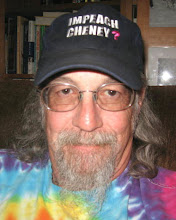Also in Environment
How Much of Your Food is Being Nuked Before it Hits the Shelf?
Brita Belli
How We Can Survive the Age of Energy Anxiety
Peter Teague, Jeff Navin
There's a Lot You Don't Know About What's in Your Food
Vanja Petrovic
Is Texas Now Greener than California?
Kate Galbraith
Bush Flips Off Spotted Owls (and the Rest of Us)
Kelpie Wilson
A glistening wind turbine stands outside the Great Lakes Science Center in Cleveland -- the city where the world's first electricity-generating windmill was built in 1888. The new machine weighs 26 tons and has kept 40,000 pounds of climate-changing carbon dioxide emissions out of the atmosphere.
Gazing skyward, United Steelworkers president Leo Gerard was impressed. "Twenty-six tons!" he marveled, mentally calculating how many manufacturing jobs that equaled -- before he learned that this particular machine was built in Denmark. "That seems pretty dumb," Gerard said. "We figure out how to make it work. And then someone in another country makes something of it and ships it back to us."
The scene occurred last fall, when Gerard, 60, was on a three-day, three-state barnstorming tour with Sierra Club executive director Carl Pope. The two men were trumpeting their joint interest in clean-energy solutions at events in St. Paul, Minneapolis, Cleveland, Columbus, and Philadelphia. They encouraged elected officials to support wind and solar power and energy efficiency as ways of creating jobs, pumping up the U.S. economy, and fighting global warming.
Standing side by side, Gerard and Pope are a study in opposites -- Gerard is enormous beside the short, slim Sierra Club leader. Gerard is brash; Pope is circumspect. One is from a small town in Canada, the other from a big city in the United States; one went to night school, the other to Harvard University. "Leo is about as different from me as anybody can be," Pope says, "except in the way he thinks."
Gerard's United Steelworkers union -- the largest industrial union in North America, representing 1.2 million workers in the United States and Canada -- has been fighting for clean workplaces and communities since the 1960s. It helped pass landmark U.S. legislation regulating air and water pollution and toxic waste, as well as "right-to-know" laws, which require companies to tell the public how much pollution they are releasing. "We need to put an end to the lies, the myths, the hysteria, that say you can have either a clean environment or good jobs," Gerard says. "You can have both, or you have neither."
When Gerald was growing up, his father worked as a miner in Ontario, Canada. Inco, the company that owned the mine, also ran an adjacent smelter that was the dirtiest in North America. The eldest of five kids, Gerard grew up in an Inco town, lived in an Inco house, and went to an Inco school. When sulfur fumes from the smelter wafted through his home, his father would say, "That's the smell of jobs." Gerard ran track in high school and says he was 16 years old "before I realized you didn't have to suck in sulfur while you were running."
Gerard's father belonged to a miners' union and held shop-steward meetings in the family basement. His mother served sandwiches and coffee while Gerard sat on the basement steps, taking it all in. He describes himself as an "irreverent" youngster, impatient with high school. "The stuff they were teaching me was how to have a good memory. I resented the system because I thought it marginalized people," he says.
At 18, Gerard went to work at the smelter. "After a few years I decided that I'd like to do something different," he says. "So I started going to night school. There was a part of me that wanted to be an economics professor." When he was offered a basketball scholarship to attend college full-time, though, he sat down and did the math.
"I was making half-decent money. At the end of four years, I would have been about 25 grand worse off if I accepted the scholarship. So I said to hell with it," he says. "I figured it would take me eight years to get my education through night school, but so what. All that time I'll be earning money."
That was the plan, but in 1977, the Steelworkers offered Gerard a job doing fieldwork based in Toronto. "And there you go," he says, ticking off a series of union jobs that eventually led to his election as United Steelworkers president in 2001. Instead of teaching economics, the irreverent kid who had yearned to become a professor was in a position to change the economic future of North America.
The full name is such a mouthful -- the United Steel, Paper and Forestry, Rubber, Manufacturing, Energy, Allied Industrial and Service Workers International Union -- that Gerard's union is simply called the United Steelworkers (USW), for the people who founded it in 1942.
This diverse group is deeply engaged in the key issues facing U.S. and Canadian workers: healthcare, pensions, and "offshoring," the trend toward moving North American industries and jobs overseas. It is also working for broader, longer-term goals such as worldwide standards to protect industrial workers, worker-friendly pension-fund investments, and the union's ground-floor membership in what the Steelworkers see as North America's emerging clean-energy economy.
While promoting the union's causes, Gerard can be intimidating. Once when it was his turn to speak at a steel company's shareholder meeting, the lights suddenly went out. "This is no time to be f -- -ing with the lights," he barked. "Get them back on or somebody's going to beat the sh -- out of you." Suddenly the room brightened, and Gerard was able to say his piece.
See more stories tagged with: environment, labor
Joan Hamilton stepped down as Sierra's editor in chief in March to become a freelance writer and editor. She is based in Berkeley, California. Contact her at joanham@gmail.com.





















No comments:
Post a Comment